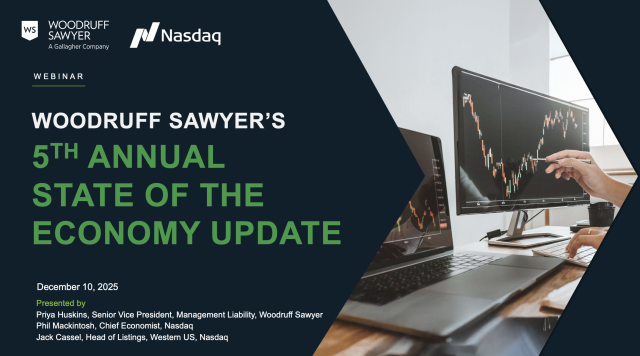Blog
Private Company Litigation: Yes, It Can Happen to You
Private companies do not typically suffer the same level of scrutiny as public companies, but they can still be sued and investigated, and sometimes with considerable press. The risks range from derivative suits to government enforcement and everything in between.
Major disputes that involve private company founders, board members, investors, and regulators can be extremely disruptive for smaller organizations, many of which may not have the same resources or protections in place.
In this article, I will outline some of the litigation scenarios that private companies face today. These kinds of disputes highlight why private company D&O insurance can be a critical safeguard for directors and officers, as well as the companies they serve.

What the Data Say About Private Company Litigation
Directors and officers do not like any litigation, of course, but litigation is relatively less problematic when it is brief and inexpensive.
When litigation costs $1 million or more, however, it is much more concerning.
AIG helpfully published an analysis of claims it has received for $1 million or more on private company D&O policies issued from 2016 to 2020. According to this analysis of AIG claims:
- Antitrust and bankruptcy claims accounted for 37% of amounts paid
- Customer and competitor claims accounted for 34% of the claim count, making up 25% of total losses paid
- Shareholder/breach of fiduciary duty claims represented 20% of the claim count, driving 23% of losses paid
- Regulatory claims represented 20% of overall claims in the study
Surprisingly, for smaller private companies (under $500 million in assets), regulatory claims accounted for 17% of total losses, showing that even relatively low visibility companies are not immune to government oversight.
The data show that litigation against private companies is diverse; the data also show that the litigation can be financially significant. The average claim in the analyzed cohort can easily reach into the millions, sometimes tens of millions.
The AIG report noted the highest average claims payments were as follows:
- Antitrust: $7.1 million (highest severity overall)
- Shareholder/breach of fiduciary duty: $4.3 million
- Bankruptcy: $3.7 million
- Regulatory: $2.9 million
- Customers or competitors: $2.7 million
Now that we have explored some of the statistical data, let us turn to some real-world examples of private company litigation.
Real-World Case Studies of Private Company Litigation
As a reminder, it was a private company—Blue Bell Creameries—that gave us the seminal case for the modern view of failures of board-level risk monitoring leading to a breach of the duty of loyalty.
That is the case in which a shareholder sued the board after a listeria outbreak caused three consumer deaths, not to mention financial turmoil including plant shutdowns and layoffs.
The issues were serious, and evidence of the board’s having put in place a system reasonably likely to bring risk issues to its attention was, at best, sparse. The case ultimately settled for $60 million.
UC Law San Francisco’s Startup Litigation Digest, published quarterly, reports on various types of private company litigation. This excellent resource provides case summaries that highlight the types of allegations that can pull a private company into costly litigation.
Government Actions
Perhaps surprising to many is the number of suits brought by the government against private companies, including their officers.
For example, Securities and Exchange Commission (SEC) investigations can result in enforcement actions, financial penalties, and even parallel criminal charges—all reminders that private status does not shield companies from federal oversight.
Here are two recent, high-profile cases involving US private companies.
Slync
Slync was a Dallas-based supply chain software startup that raised millions from investors before the founder’s misconduct put into motion the company’s downfall.
As highlighted in Issue 3 (2024) of the Startup Litigation Digest, Christopher Kirchner, the company’s co-founder and former CEO, faced civil and criminal charges for misappropriating investor funds.
According to the SEC, Kirchner misrepresented Slync’s finances by overstating customer revenue and contracts, all the while raising more than $67 million.
The regulatory agency found that Kirchner used more than $28 million of those funds for personal gain, including the purchase of a $16 million private jet, entertainment expenses, and transfers to his personal investment entity.
Meanwhile, the company struggled to make payroll. Kirchner attempted an unauthorized “Series C” fundraising round to make ends meet. He then fired an employee who reported his misconduct to the board. He also tried to delete company data after being suspended from the board.
Federal prosecutors brought parallel charges, and in 2023, a Texas jury convicted Kirchner on multiple counts of wire fraud and money laundering.
Kirchner was ultimately sentenced to 20 years of prison time, as well as SEC penalties including disgorgement, civil fines, and a bar from serving as an officer or director.
Ozy Media
Ozy Media was a Silicon Valley-backed digital media company founded in 2013 and based in Mountain View, California.
Co-founded by former journalist, TV personality, and entrepreneur Carlos Watson, and former COO Samir Rao, the company raised more than $80 million from high-profile investors.
It pitched itself as a new model for millennial media, with newsletters, video shows, podcasts, and events like “OZY Fest.”
But as detailed in Issue 1 (2023) of the Startup Litigation Digest, Ozy Media’s credibility began to unravel after a bizarre incident in 2021, as detailed by the New York Times in the feature: Goldman Sachs, Ozy Media and a $40 Million Conference Call Gone Wrong.
During a fundraising call with Goldman Sachs, Rao pretended to be a YouTube executive who was allegedly on the call to boost claims about Ozy Media’s relationship with the video-sharing platform.
When that hoax was discovered, Watson told investors and Ozy’s board that Rao had suffered a mental health crisis. The board initially accepted that explanation.
However, by 2023, regulators and prosecutors were involved. The SEC charged Ozy Media, Watson, Rao, and former chief of staff Suzee Han with defrauding investors of about $50 million.
The Department of Justice also filed criminal charges. Prosecutors alleged that Watson, Rao, and Han not only misled investors but also tried to deceive banks and lenders.
According to the indictment, Ozy Media executives fabricated contracts, forged signatures, and even used voice-altering software and fake email accounts to impersonate key people in the course of their business dealings.
In December 2024, Watson was sentenced to nearly 10 years in federal prison. He received a presidential pardon in March 2025.
Protection for Private Companies
Litigation against private companies, like the cases described in this article, can be costly, messy, and personal. That’s why having the right directors & officers liability insurance can be critical for certain private companies.
Of course, the win is never being caught up in litigation in the first instance. When it happens, however, it’s a good time to have D&O insurance. This is something we discuss further in Woodruff Sawyer’s Guide to Private Company D&O Insurance, which is a playbook designed to help private companies understand their risks and evaluate how the right coverage can protect their leaders when disputes like these arise.
You can also check out UC Law San Francisco’s Startup Litigation Digest for more cautionary tales involving fiduciary duty claims and private companies—there are plenty.
Disclaimer
The information contained herein is offered as insurance industry guidance and provided as an overview of current market risks and available coverages and is intended for discussion purposes only. This publication is not intended to offer financial, tax, legal or client-specific insurance or risk management advice. General insurance descriptions contained herein do not include complete insurance policy definitions, terms, and/or conditions, and should not be relied on for coverage interpretation. Actual insurance policies must always be consulted for full coverage details and analysis.

Author
Table of Contents











